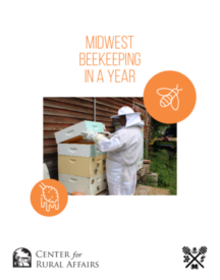Para la versión en español, por favor oprima aqui.
Beekeeping looks different in every state, and in every different climate. This fact sheet provides an example of an average Nebraskan beekeeper's year.
01. January
Start reading a book on beekeeping, sign up for specialized classes, join a group, or subscribe to magazines.
02. February
Order bees, get supplies ready, fix or replace anything you need to.
03. March
During a warm day, examine all of your hives. Double-check the bees that are not active (flying). you should see bees flying in and out (cleansing flights) when it is around or above 40 degrees F. Remove any hives that are dead to prevent pests from destroying drawn-out comb. Check on food stores, add more sugar or a candy board.
04. April
Check food stores. Completely remove all winter thermal insulation. Clear off bottom boards and check for a laying queen if warm enough. Feed colonies with sugar water to stimulate wax production and colony growth:
2 cups water: 1 cup sugar
Bee packages will arrive. Prior to installation, make sure your prep your site.
05. May
Watch for population growth on overwintered hives; early May is a good time to do a split to prevent swarming. Check for varroa mites with a sugar roll, and make a plan to treat. Pay attention to time between supering the hive and treating the hive, if needed.
06. June
Swarms in June are worth a silver spoon! Watch out for swarms, and have a set-up ready to move one in if you want. Supering may be needed; pay attention to population growth.
07. July
Watch the flow of honey. Continue to monitor population growth, how much of the previous super is drawn out, and floral resources.
08. August
Start preparing for honey harvest. Watch hives for robbing behavior and monitor floral resources in case of a dearth.
09. September
Honey harvest! Honey should be harvested before the goldenrod starts to bloom. Make sure you have an indoor space that is warm to store supers. Honey harvest is quicker when the room is warm.
After honey is harvested, do another sugar roll and check for varroa mites. Make a treatment plan, if necessary.
10. October
Feed 2:1 syrup (2 cups sugar to 1 cup water) to help bees fill up the two deeps needed for winter survival, and treat for mites. Continue mite treatments if needed; do a final check. After the first frost, put on mouse guards.
11. November
Winterize. Cover hives with black tar paper or hive covers for insulation and wind protection. Make sure hives are protected from the north wind. Be sure you have a vent hold on top; this is very necessary to prevent moisture accumulation. Place candy board or granulated sugar in hive for extra food stores.
12. December
Review your beekeeping year. What went well? What could have gone better? What do you want to change? Do you need to expand? Register hives with USDA Farm Service Agency for ELAP (Emergency Assistance for Livestock, Honey Bees and Farm-Raised Fish) protection by Dec. 31.
This calendar is funded by the Beginning Farmer and Rancher Development Program (BFRDP) of the U.S. Department of Agriculture's National Institute of Food and Agriculture.


